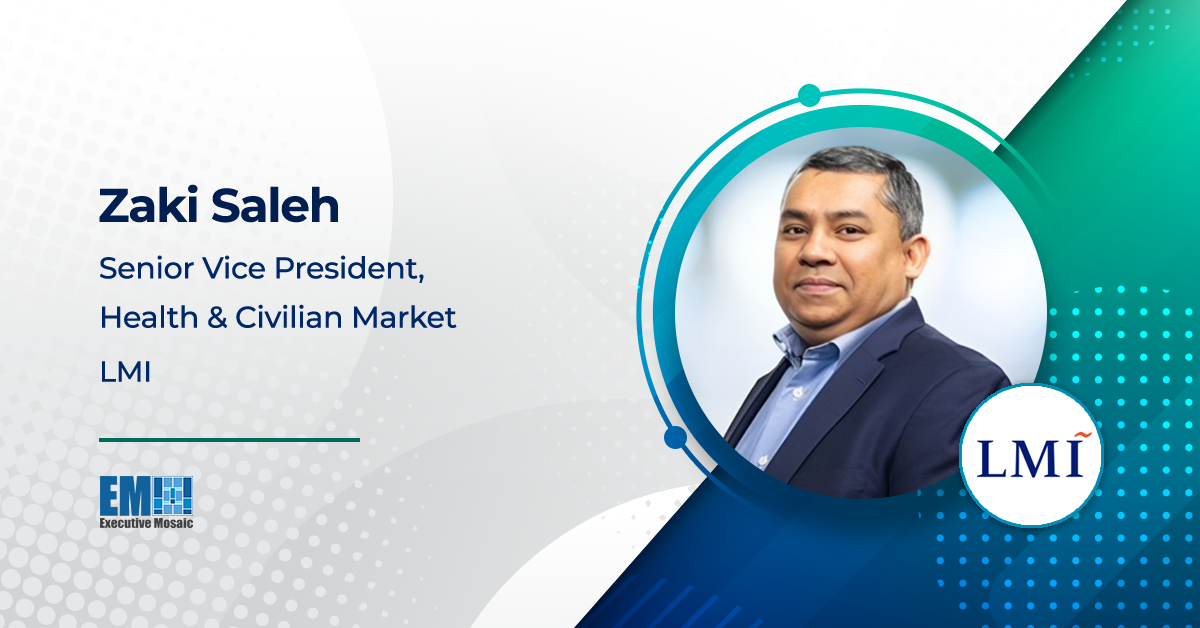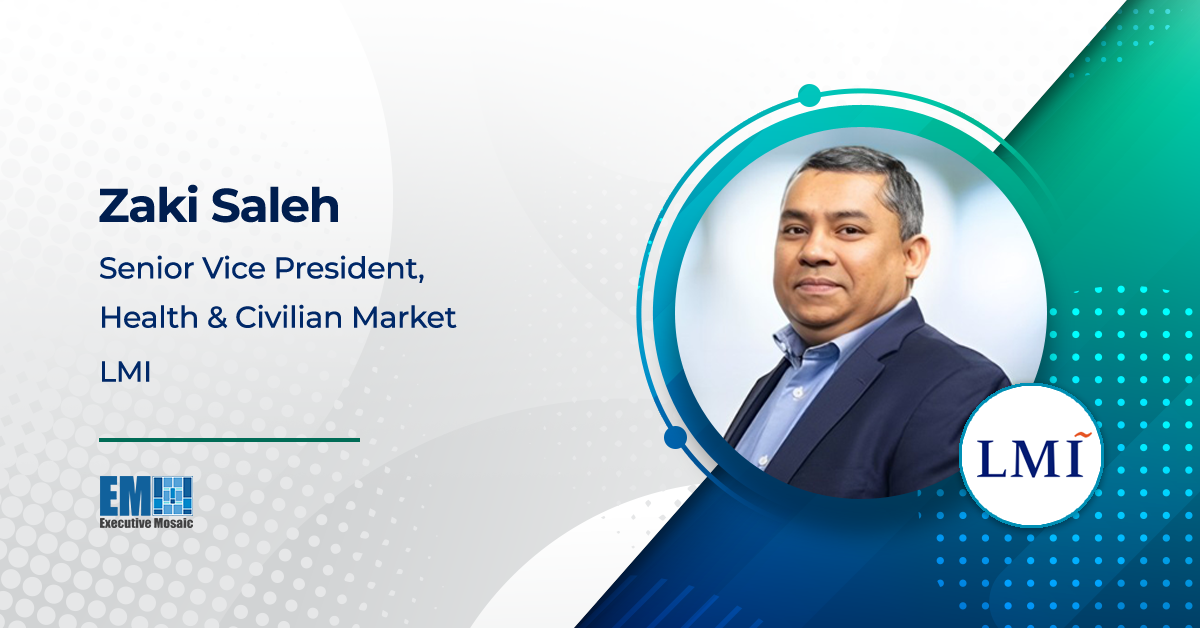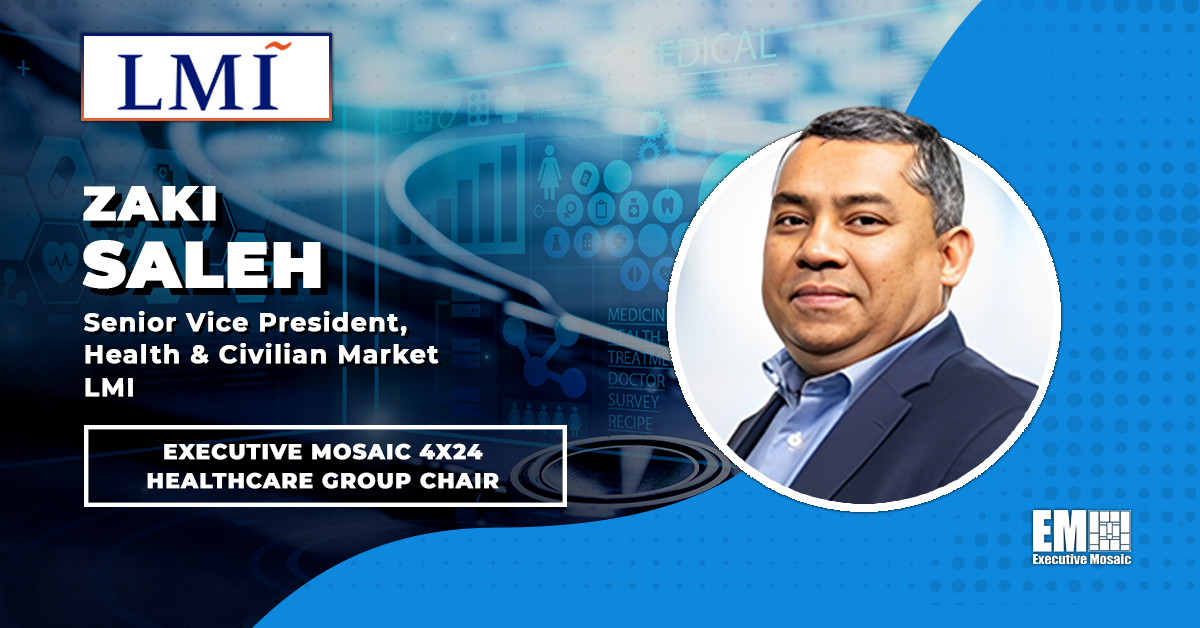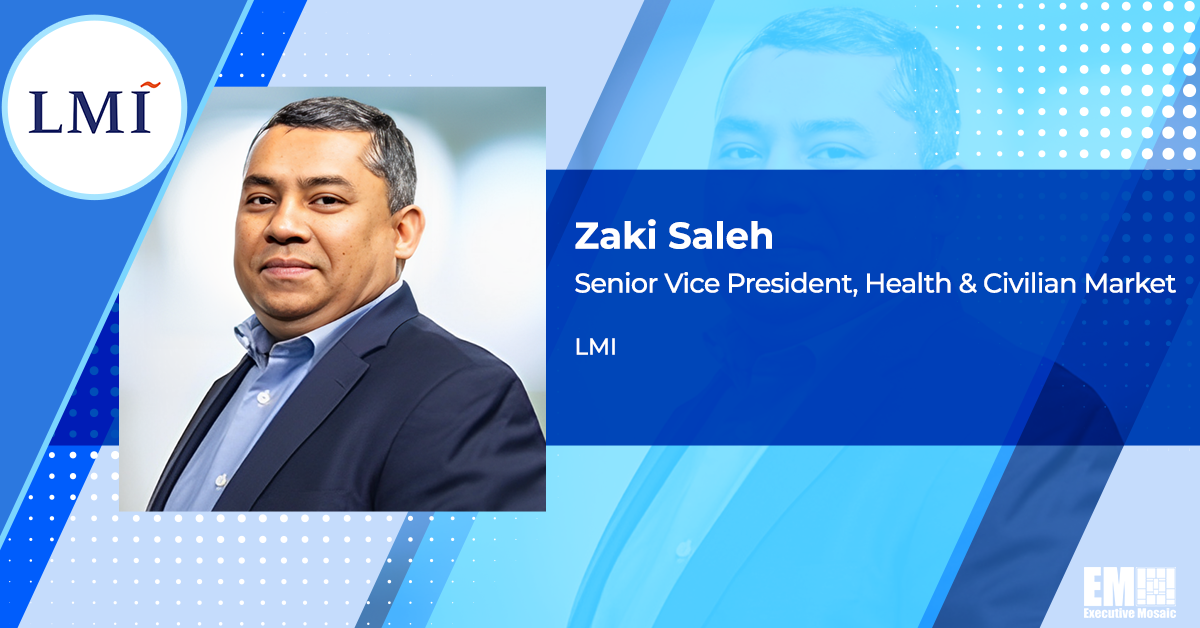Zaki Saleh currently serves as senior vice president of the health and civilian market at LMI, where he leads profit and loss and growth efforts for the sector. Prior to joining the company, he was vice president of Peraton’s global health unit, and he previously spent over a decade at Northrop Grumman managing business development functions for several divisions.
In September, Saleh was named chair of the Healthcare Group within Executive Mosaic’s 4×24 Leadership Series, where he works to foster collaboration between government and industry healthcare experts as they tackle key challenges federal healthcare organizations face.
Saleh recently participated in an Executive Spotlight interview with GovCon Wire, where he shared his insights on generative artificial intelligence and large language models – which he sees as some of today’s “most disruptive technologies” – and discussed the ways in which the public and private sectors can come together to ensure that federal organizations are equipped with the technologies necessary for mission success.
Generative artificial intelligence, or genAI, has been the source of a major artificial intelligence boom in recent months, but some of these tools are also proving to be risky. How do you think cybersecurity will have to evolve to stay ahead of potential threats posed by AI tools?
Generative AI’s dependency on curated data makes it an appealing point of focus for those with malicious intent, bringing new risks and threats to the cybersecurity landscape. Because genAI models are shaped by the data that is used to train them, this data can be exploited to result in adversarial AI attacks with harmful results. LMI cybersecurity experts have been exploring ways to get ahead of these types of threats using intelligent models that make proper disposition of data noise. They use enhanced data validation, continuous model monitoring, collaboration and information sharing, regulatory frameworks and LMI’s zero trust approach, which emphasizes verification and authenticity, to negate these techniques. As the landscape evolves, LMI will continue to join forces with our customers, government and academia, and share risks as they arise to continue to find creative ways to defend and circumvent potential future risks.
Data is often coming from multiple sources that organizations need to collect, analyze and understand in order to use it. What are some of the key challenges and opportunities you’re seeing emerge as organizations harness data and use it to drive decisions?
First and foremost, organizations need to be able to trust their data sources. Data quality, data provenance and data lineage all need to be derived with credibility. From there, data integration needs to be considered while ensuring the appropriate framework and infrastructure are put into place to scale the data properly. Challenges can also exist when it comes to managing overall costs and enforcing proper governance as the data is utilized. That being said, overcoming these challenges is worth the advantageous opportunities. If done correctly, this data can provide insight and speed to actionable decision-making while providing unprecedented awareness. As the data matures, it can position an organization for future technological innovations and help it adapt to changes over time. For example, having a core foundation of a well-trained workforce and a rigorously developed set of processes will help an organization adapt to an evolving work environment. Data can be used to close gaps in established and outdated thinking and processes, as well as to allow for greater creativity and innovation.
What kind of tools and technologies can organizations use to make their data more accessible and understandable?
With the explosion of tools and technology in this landscape, it’s important to strike a balance between properly vetting how they are implemented and sacrificing the speed at which we deliver them to end users. There is a natural proclivity to want to implement the latest seemingly revolutionary technology — we’re seeing that now with genAI, which is poised to absolutely be a disruptive innovation — but understanding how to properly integrate it into your existing organizational infrastructure to address your core mission and business value is just as, if not more, important than simply staying ahead of the hype cycle curve. For example, LMI has developed a genAI tool, LIGER™, that can be implemented within a government customer’s firewall to safeguard sensitive government data and allow the government to increase the accuracy of its genAI and LLMs.
Using LIGER™, LMI is helping customers across several different agency landscapes. For example, LMI is piloting a Policy Chat for a government healthcare customer that allows teams to ask the LLM questions and receive a tailored answer with a citation to the sources, turning what would once take hours to research into a quick inquiry. For a defense customer, LMI developed an Alternative Supplier Analysis tool that identifies the suppliers of rare earth-metals needed to produce a magnet for aircraft engines in less than a minute, a task that previously would have taken up to six weeks to pinpoint. We are also supporting a government agency’s OpenAI testing initiative, working with their analytics team to use OpenAI’s LLMs to extract knowledge, skills, activities, tasks, technologies and the relationships among them from unstructured human capital data sources via entity extraction. For another government agency, LMI is prototyping a modeling and simulation workforce planning tool that uses LLMs to reduce time to insight by analyzing real-time simulation results through a customized user-interface.
Which emerging technologies do you anticipate will have the greatest impact on the federal landscape in the next few years?
Generative AI and LLMs are undoubtedly some of the most disruptive technologies that we’ve seen in recent years, and we should expect the combination of these tools to continue changing the way that organizations approach an array of tasks. In particular, federal agencies should expect to see significant return on investment from tailoring LLMs to focus on high performance results around specific tasks. This could include using LLMs to augment Tier 1 helpdesk activities, improve policy management and rationalization, transform the way process automation is performed and even better enable the development and analysis of novel datasets that can be used to improve decision making.
Stable, scalable technology platforms that can be used to support everything from LLMs and genAI solutions to other analytics and DevSecOps needs of an organization are also increasingly important in the federal environment. Platforming engineering solutions allow organizations to reduce costs and risks within data, analytic and software/application development activities by using consistent infrastructure, uniform security and a standard suite of tools that promote interoperability. To ensure the right technologies, tools and capabilities are selected, the government should leverage industry partners who bring a technology agnostic perspective and focus on identifying the best technologies to address organizational needs. This type of technology integration partner can help government organizations accelerate technology adoption by identifying emerging technology disruptions using data driven horizon scanning and by focusing tech deployment on solution integration, interoperability and end-user adoption.
What’s the most challenging aspect of transitioning from R&D and prototyping to actually fielding a new technology, and what solution would you propose for this challenge?
Transitioning from R&D and prototyping to fielding a new technology presents a unique set of challenges, with the ultimate end goal of avoiding the “valley of death.” One of the larger hurdles is managing expectations between all stakeholders. The traditional mindset of “ship it and that’s what you have to live with for a long while” is dated with the current rapid pace of technological development. We now know that an agile approach of fast failure, rapid iteration and continuous improvement, like the approach used by the Forge™, LMI’s technology accelerator, is the most innovative way to field new technology, as capabilities are added to the original technology over the process period. A strong focus on human-centered design, change management, effective communication and continuous engagement with stakeholders should help avoid organizational and people-oriented challenges and ensure a smoother transition.






